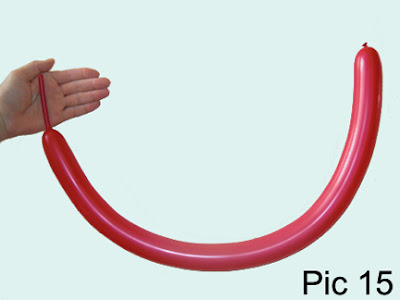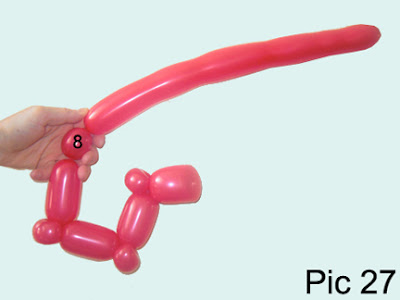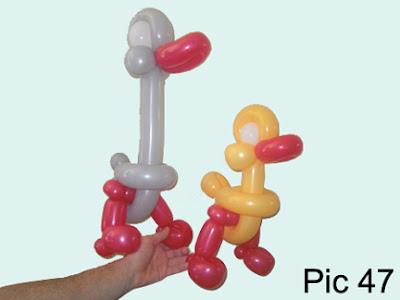Buy balloons on Amazon (paid link):
Buy an air pump on Amazon (paid link):
We are going to use three balloons to make a bird. There are basically two important difference of how we make duck, goose or ostrich: the size and colors. I use yellow balloon to make a duck. Goose is gray. And ostrich is brown. Goose has long neck. Ostrich has long neck and two-toed legs. The rest is about the same. Let’s first make the duck. Inflate yellow balloon leaving a two—inch flat tail (Pic 1).
Twist the first soft five—inch bubble (Pic 2).
Lock both ends of the first bubble in one lock twist (Pic 3).
Twist the second soft three—inch bubble (Pic 4).
Lock both ends of the second bubble in one lock twist (Pic 5).
Twist the third soft three—inch bubble (Pic 6).
Lock both ends of the third bubble in one lock twist (Pic 7). We made the head of the duck.
The next three bubbles we twist to make the neck/ body, the wings/ body and the tail of the bird. We have to decide what kind of tail we are going to make and how long the neck is going to be. Usually I twist the last bubble (the tail of the bird) first. And then I split the middle of the balloon on two bubbles to make the neck/body and the wings/body. Just to make this instruction easier to follow we will twist bubbles in the order as they go. Twist the fourth about ten—inch bubble (Pic 8). It is the neck/ body.
Twist the fifth about ten—inch bubble. The rest of the balloon is the soft sixth about four—inch bubble (Pic 9).
Lock both ends of the fifth bubble in one lock twist (Pic 10). We made the wings/ body of the bird.
We can keep the sixth bubble as it is. Or we can lock both ends of the sixth bubble in one lock twist (Pic 11). It represents the tail of the bird.
Force the fourth bubble half way through the loop of the fifth bubble (Pic 12 through 14). The upper part of the fourth bubble represents the neck of the bird. And the bottom part of the fourth bubble represents the belly of the bird.
Inflate the red or orange balloon leaving three—inch flat tail to make the legs (Pic 15).
Twist the first soft four—inch bubble (Pic 16).
Lock both ends of the first red bubble in one lock twist (Pic 17).
Twist the second red soft one—inch bubble (Pic 18).
Lock both ends of the second bubble in one lock twist (Pic 19). We made the foot.
Twist the third red three—inch bubble (Pic 20). It is a leg.
Twist the fourth soft one—inch bubble (Pic 21).
Lock both ends of the fourth bubble in one lock twist (Pic 22). This bubble keeps the leg in fixed position.
Twist the fifth three—inch bubble (Pic 23).
Twist the sixth soft one—inch bubble (Pic 24).
Lock both ends of the sixth bubble in one lock twist (Pic 25). This bubble will keep the second leg in fixed position.
Now we are going to make the second leg. Twist the seventh three—inch bubble (Pic 26).
Twist the eighth soft one—inch bubble (Pic 27).
Lock both ends of the eighth bubble in one lock twist (Pic 28). This bubble will keep the foot in fixed position.
Twist the ninth soft four—inch bubble (Pic 29).
Lock both ends of the ninth bubble in one lock twist (Pic 30). We made the second leg. The rest of the balloon is the tenth bubble.
Cut off nicely the tenth bubble and tie off the ends. We are going to use the tenth bubble to make the beak of the duck (Pic 31).
Pull one leg (red balloon) through the loop between the yellow fourth and the yellow fifth bubble. We can move the fourth yellow bubble up and down through the loop of the fifth yellow bubble to make it easier for us to pull the legs (red balloon) through the loop (Pic 32 through 34).
Now we are going to make the eyes. Inflate a white (or whatever color eyes you like) soft four—inch bubble and tie both ends of this bubble in one knot (Pic 35).
Attach the white bubble between the first three yellow bubbles (Pic 36).
Force the white bubble half way through the loop of the 1st yellow bubble (Pic 37 and 38). We made the eyes. You can use a permanent black marker to draw the eyes.
Now it’s time to use the tenth red bubble to make the beak (you should use another balloon to make the beak if the the tenth bubble is too short for it). We can make different beaks. Attach one end of the tenth red bubble between the first three yellow bubbles (Pic 39 through 40). We can use short red bubble to make this beak.
Lock both ends of the tenth red bubble in one lock twist (Pic 41 through 45). We can bend the beak up to make it look better. Congratulations, you have made the duck.
Use the gray balloon to make the goose body. This time you have to twist one—inch bubble for the tail. It gives the extra length for the neck (Pic 46 and 47). We also can make the legs one inch longer for the goose.
Use a brown balloon to make the body for the ostrich (Pic 48 and 49). The body is exactly the same as goose body. I use an orange balloon to make long legs. And make two—toed feet for the ostrich. Instead of one four-inch bubble as for the ducks' feet I twist four bubbles for each foot: two—inch bubble, chain of two one—inch bubbles, two—inch bubble. I also use a black balloon to make the eyes.
The size of birds only matters if you put them next to each other (Pic 50). Otherwise, the goose looks identical to the duck. And the ostrich is just a fancy cartoon duck.
Have fun and happy twisting :)
www.fewdoit.com
for you



















































No comments:
Post a Comment